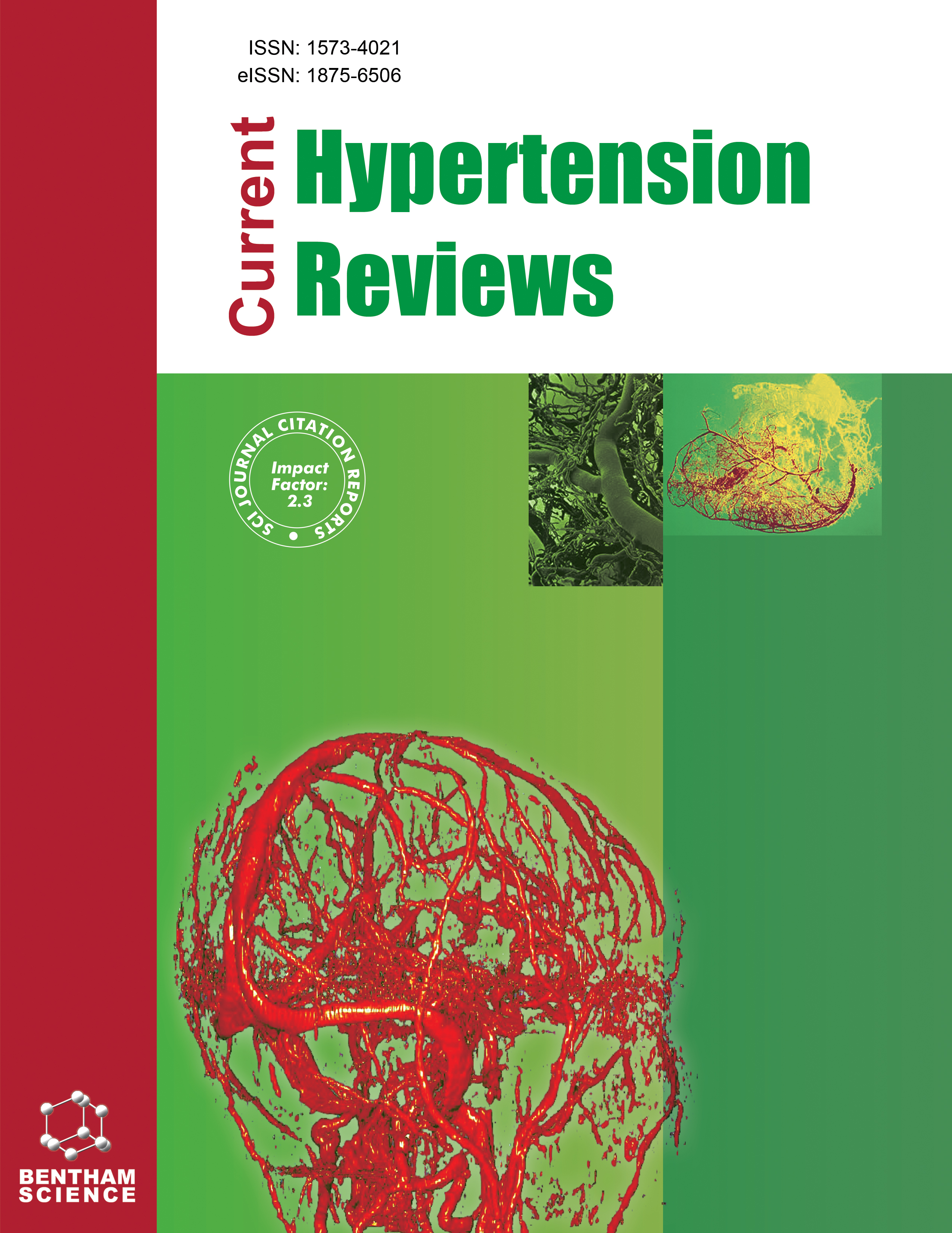- Home
- A-Z Publications
- Current Hypertension Reviews
- Previous Issues
- Volume 13, Issue 2, 2017
Current Hypertension Reviews - Volume 13, Issue 2, 2017
Volume 13, Issue 2, 2017
-
-
Hypertensive Disorders in Pregnancy Current Practice Review
More LessAuthors: Kim Turner and Afshan B. HameedBackground: Hypertensive disorders (preeclampsia, eclampsia, gestational hypertension, and chronic hypertension with superimposed preeclampsia) complicate 3-5% of all pregnancies and are a significant cause of maternal mortality and morbidity. Preeclampsia is a multi-system disorder characterised by new onset hypertension after the 20th week of pregnancy with proteinuria. Proteinuria is defined as 300 mg o Read More
-
-
-
Is There a Role for Continuous Positive Airway Pressure Treatment in the Management of Obstructive Sleep Apnea-related Hypertension?
More LessAuthors: Savvas Kolanis, Michalis Pilavakis, Areti Sofogianni and Konstantinos TziomalosBackground: Obstructive sleep apnea (OSA) is a major cause of secondary hypertension. Moreover, a considerable proportion of patients with essential hypertension have OSA. OSA also appears to increase the risk for cardiovascular disease and all-cause mortality. Continuous positive airway pressure (CPAP) treatment substantially reduces daytime somnolence and improves quality of life in patients with OSA. However, Read More
-
-
-
Current Status of Renal Artery Angioplasty and Stenting for Resistant Hypertension: A Case Series and Review of the Literature
More LessAuthors: Antonis S. Manolis, Antonis A. Manolis and Helen MelitaBackground: Renal artery stenosis (RAS) has a high prevalence in older patients, especially in the context of general atherosclerosis. It is frequently associated with resistant hypertension and impaired renal function and their attendant consequences. The issue whether revascularization via percutaneous renal angioplasty and stenting (PRA/S) can benefit these patients remains unsettled. Objective: To present a case series of Read More
-
-
-
Alerting Reaction in Office Blood Pressure and Target Organ Damage: An Innocent Phenomenon?
More LessBackground: An alerting reaction is a physician-induced phenomenon which produces a transient blood pressure rise in the office. Objective: To determine its relationship with target organ damage in treated hypertensives. Method: We used three different indexes for calculating alerting reaction depending on the first, second or third office blood pressure measurement. We correlated these indexes with glomerular filtrati Read More
-
-
-
Effect of Statin Therapy on the Progression of Autosomal Dominant Polycystic Kidney Disease. A Secondary Analysis of the HALT PKD Trials
More LessBackground: Autosomal dominant polycystic kidney disease (ADPKD) commonly results in end-stage renal disease (ESRD), yet a long-term treatment that is well tolerated is still lacking. In a small randomized trial in children and adolescents pravastatin administration for 3 years was associated with reduced renal cyst growth, but no large trial has tested the effect of statins in adults. Methods: We performed a post-ho Read More
-
-
-
Ambulatory Arterial Stiffness Index (AASI) is Unable to Estimate Arterial Stiffness of Hypertensive Subjects: Role of Nocturnal Dipping of Blood Pressure
More LessBackground: Ambulatory Arterial Stiffness Index (AASI) has been proposed as an indirect and simpler method to estimate the Arterial Stiffness (AS). AASI, calculated from a set of data collected during a 24-hours ambulatory blood pressure monitoring (ABPM), is defined as 1 minus the regression slope of diastolic on systolic blood pressure (BP) values. For a given increase in diastolic BP, the increase in systolic BP is smaller in a co Read More
-
-
-
Effect on Morphology, Osmotic Fragility and Electro Kinetic Potential of Erythrocytes in Hypertension
More LessAuthors: S.S. Gaikwad and J. G. AvariBackground: Hypertension is a common health problem concerning a large proportion of population and a leading global risk factor for the burden of cardiovascular disease (CVD). The purpose of this study was to assess the efficacy of the erythrocyte zeta potential as a potential additional indicator for cardiovascular disorder risk so that patients with this can be more rapidly identified and treated. Methods: In the present st Read More
-
-
-
Depression and Medication Adherence in Patients on Hemodialysis
More LessBackground: Depression is highly prevalent in End Stage Renal Disease (ESRD) and is the most common psychiatric disorder in this population. Depression is associated with a lack of adherence to hemodialysis (HD) treatment regimens and increased morbidity and mortality. Methods: A descriptive secondary correlational analysis of 118 patients on chronic HD was conducted to determine the prevalence of depression an Read More
-
Volumes & issues
-
Volume 21 (2025)
-
Volume 20 (2024)
-
Volume 19 (2023)
-
Volume 18 (2022)
-
Volume 17 (2021)
-
Volume 16 (2020)
-
Volume 15 (2019)
-
Volume 14 (2018)
-
Volume 13 (2017)
-
Volume 12 (2016)
-
Volume 11 (2015)
-
Volume 10 (2014)
-
Volume 9 (2013)
-
Volume 8 (2012)
-
Volume 7 (2011)
-
Volume 6 (2010)
-
Volume 5 (2009)
-
Volume 4 (2008)
-
Volume 3 (2007)
-
Volume 2 (2006)
-
Volume 1 (2005)
Most Read This Month
Article
content/journals/chyr
Journal
10
5
false
en


